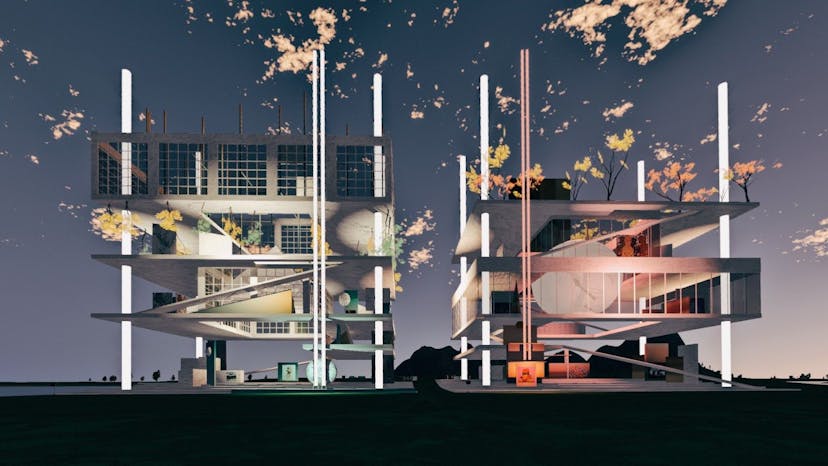New NFTs Will Let Virtual Museum Show Art Across the Metaverse
The Museum of Crypto Art is making exhibition spaces for all cornes of the metaverse.
By: Brady Dale • Loading...
DeFi
The metaverse is vast, but it’s not yet interoperable.
A new series of NFTs dropping early next year could bridge its many universes, at least for art curators. The Museum of Crypto Art (MOCA) has a plan to show artwork in as many corners of the metaverse as it can.
The nice thing about digital art is the fact that it can be very widely seen, and MOCA is creating exhibition spaces that can be easily copied into each corner of the metaverse, like Somnium, Decentraland, Cryptovoxels and, maybe, one day, whatever the company formerly known as Facebook is making.
“We are not providing a virtual world,” Reneil, MOCA’s technology director, told The Defiant in an interview. “We assume lots of virtual worlds come up. We want to be there, we want to be available with open APIs so all these worlds can feed their world with content, with art exhibitions right from the start.”
The museum staff’s experience has shown that there can be serious technical friction for curators that want to show art widely, after all each world uses its own tech stack and its own software languages with its own rules. “We have been doing metaverse exhibitions and exhibitions IRL and it’s super complicated to get all the artworks that can be displayed on the metaverse or the screens,” Reneil said.
To reduce that friction, MOCA will launch an NFT program next year that will create spaces that can be replicated across many virtual worlds, as fast as MOCA can get agreements to do the integrations. It’s a way of enabling art to bridge into many places and be seen by as many people as possible.
Metaverse Architects
As of now, it has an agreement in place with Mona Gallery, a virtual space backed by Filecoin, and it’s in discussions about bridges to other virtual worlds.
“MOCA’s vision is to bring metaverse architects, designers, artists, and enthusiasts together to create worlds, museum wings, and exhibits of revolutionary style and scope. We want to challenge the very idea of ‘Architecture’ just as we’ve challenged the concept of a ‘Museum,'” the organization wrote in a statement for The Defiant.
The NFT program will work in two parts. First, every 24 hours there will be an auction for a FLOOR NFT. Each auction has to be triggered by a buyer, and that buyer won’t know anything about the floor they are triggering. Once triggered, though, the smart contract will issue a FLOOR NFT that will have a number randomly determined by the smart contract. That number will indicate the number of artworks it can hold.
Designed Space
The smallest rooms will hold eight artworks and the largest will hold 1,024, but there will be a very low probability that a room could be on the extra-large end. The probability range of room sizes has not been determined yet, according to Reneil.
Whatever its size is, that’s fixed forever on the blockchain. A ROOM can hold no more works than the FLOOR NFT allows.
The auctions will take place on Ethereum, and then if the NFT holder ports their token to Polygon they can exchange it for an actual designed space. These spaces will be designed by architects who are paid by MOCA, such as Untitled,XYZ, who we spoke with recently. Once they pick their ROOM NFT it’s fixed, that design is locked in. The architect can update it to keep it current with technology, but it won’t be redesigned.
“Generation-1 ROOMs will have one architect, UntitledXYZ, and two design concepts for owners to choose between: “Order” and “Chaos,”” according to MOCA. Later, other architects will join. The precise remuneration plan is still being sorted, but the current thinking is the chosen designers will be streamed MOCA tokens using Superfluid at equal rates.
“In the best case it’s not about money. It’s about the prestige to be an architect for MOCA, to be whitelisted for that,” Reneil said.
Once they have picked a design, they can curate it with their own works or works from the museum’s collection. Then they can swap out artworks whenever they want. If they have the room copied to multiple universes or if they have permitted others to copy their space elsewhere in the metaverse, changes will be immediately reflected everywhere it appears.
Aesthetic Possibilities
“Owners can do whatever they want with their space. Of course they can; it’s theirs,” the statement said.
Sales of ROOMs will create royalties for their architects in perpetuity. Sales of FLOOR tokens will be used to purchase MOCA’s governance token, MOCA.FLOOR auctions should begin in early January, Reneil said. ROOMs will be further out, as the architect does designs based on the room sizes that show up.
“ROOMs are an important early puzzle piece of the metaverse, one which will allow a growing audience to experience its grand aesthetic possibilities while also being a key tool towards building social experiences around Crypto Art,” the statement said.
Advertisement
Get the best of The Defiant directly in your inbox 💌
Know what matters in Web3 with The Defiant Daily newsletter, every weekday
90k+ investors informed every day. Unsubscribe anytime.